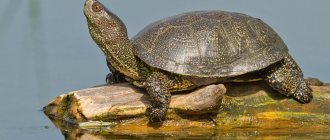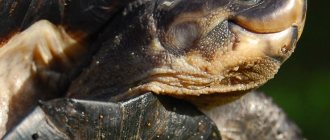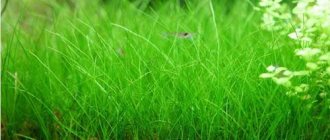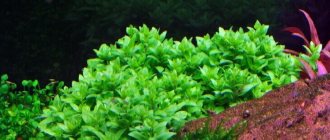Attracts attention with its unusual color scheme. By growing Proserpinac Palustris, you can enjoy all facets of yellow, red, copper and orange, as is the case with Ludwigia arcuate, Alternanthera lilac or Hygrophila pinnatifaris. Or contemplate all shades of green. Unfortunately, in poor conditions this “swamp mermaid” does not reach its potential.
Description of the plant
In addition to the original colors, it is valued for its unusual and rare for aquarium plants leaf shape, reminiscent of the outline of a spruce tree.
There are several varieties in the genus:
- Proserpinaca palustris;
- Proserpinaca intermedia;
- Proserpinaca pectinata.
The plant reacts very sensitively to the conditions of the aquatic environment, forming new forms.
Proserpinaka Palustris, unlike other representatives of the genus, has 3 subspecies:
- Proserpinaca palustris var. amblyogona Fern;
- Proserpinaca palustris var. palustris L;
- Proserpinaca palustris var. crebra Fern. &Grisc.
Often found under the name Proserpinaka Palustris "Cuba", but this is a commercial name.
The above-water form of the plant, in contrast to the underwater one, is inconspicuous. The leaf blades are olive green and blend in with the green biomass.
It is noteworthy that in its natural habitat it is considered a weed. But when submerged, this beauty becomes the highlight of any aquarium.
The unusual color of the proserpinaki deserves special attention.
Orange and red colors come from the pigment carotene, while yellow comes from xanthophyll.
To maintain color saturation, it is necessary to monitor the acidity of the aquatic environment, but more on that later.
Distribution of wild crops
Proserpinaca palustris, or swamp proserpinac, was first discovered on the Cuban island of Juventud. The plant inhabits ponds, swamps and streams. But it can also lead a terrestrial lifestyle, growing in muddy soils and wet ditches.
Proserpinaka is characterized by many different varieties that grow in different regions of the planet. Rich in this plant:
- North America;
- Eastern and Southeastern United States;
- Central and South America;
- Islands of the Caribbean.
Varieties of “witch grass” differ in appearance.
For example, the North American species has narrow, sawtooth-shaped leaves, while the Cuban variety has leaf blades that have a wide central part.
This variety is also called Proserpinaka palustris “Cuba”. In European countries, there is a demand for the Cuban variety.
Plant morphology
Under natural conditions, Proserpinaka Palustris has sawtooth leaf blades, which, after transplanting into an aquarium, radically change shape.
Main characteristics:
- Subclass - Rosids.
- Order: Sweetberry-flowered.
- Family - Sweetberry.
- Height - up to 40 cm.
- The width of the bush is up to 15 cm.
- The leaves are elongated, comb-shaped, serrated. The shape resembles needles that fan out around the stem. They are found with both small notches and deep cuts. They reach 4 cm in length and 3 cm in width.
- The internode is from 2 to 3 cm, but the stem looks lush.
Proserpinaka Palustris flowers in its emergent form. The inflorescences do not have decorative qualities.
Acanthophthalmus kuhli “traffic cop”
We offer Acanthophthalmus kuhli “traffic cop”
57.00rub
Price: 57.00 rub.
Acanthophthalmus kuhli “traffic cop”
Secretive bottom fish. So named because of its characteristic color. I suspect, and because of the craving for hide and seek - too.
DESCRIPTION: The body is worm-shaped, slightly flattened laterally in the tail area, the lateral line is absent, the scales are small. The head is small, without scales. The eyes are protected by a thin transparent leathery film. Under each eye there is a forked spike at the end.
The mouth is lower, has three pairs of antennae. The fins are small, the dorsal fin is located on the back of the body.
The body is yellow-orange to red, with 15-20 wide black-brown transverse stripes that cover the entire body only at the head, and then do not reach the lower part, and the stripes in the middle of the body can bifurcate. The lower part of the body is lighter.
Females of Acantophthalmus Kühl grow up to 12 cm in length, and males reach a length of up to 10 cm. Sexual differences: Males: the ventral fins and the second ray of the pectoral fins are thickened, the body shape does not change during spawning, eggs are not visible in the abdomen.
Females: larger and plumper than males. just before spawning, they acquire a pear-shaped shape, become thick, and light green eggs can be seen through the abdomen.
KEEPING AND BREEDING: Acantophthalmus Kühl is quite unpretentious. They need a spacious aquarium of 60 liters or more. A cover glass or lid is required, as acanthophthalmus can jump out when startled. Soil - fine sand, fine boiled peat chips, any fine rolled soil without sharp edges, into which acanthophthalmus can burrow and dig.
Water parameters: pH 5.4-7.4; dH 4-11, filtration, enhanced aeration, weekly replacement of 20% of the water volume. Temperature: 22-28°C. Lighting: moderate, diffused. Plants: places with dense thickets of small-leaved living plants that create shelters are needed, incl. floating plants to create shaded areas in the aquarium. Decoration: stones, driftwood, caves, various shelters.
Acanthus prefer small live food (bloodworms, tubifex, coretra, enchytraea, daphnia, cyclops). They also readily eat frozen and dry food. The diet should contain food of plant origin - up to 25%. The diet of Acanthopthalmus culi may also include snails, caviar and fish fry.
Since acanthophthalmus is most active at night, it is recommended to give food closer to the night, immediately after turning off the lights in the aquarium. Reproduction method: spawning.
Male to female ratio: 3:1
ADDITIONAL INFORMATION: Life expectancy: up to 10 years. Based on the behavior of Acantophthalmus Kühl, it is possible to predict the weather - so the upcoming change in atmospheric pressure is marked by very active behavior of the fish, as well as “dancing” in the water column.
When fish are not kept in a school, they become very shy and may not appear for weeks, so if you want to watch them comfortably, keep the fish in a school.
Source: https://AquaPiter.com/product/akvariumnye-rybki/akantoftalmus-kyulya-acanthophthalmus-kuhli-gaishnik
Growing and care
Opinions differ regarding the difficulty of growing Proserpinacia Palustris. But most aquarists classify it as an average level of complexity.
It is better for beginners to gain experience before breeding the “swamp mermaid”.
You need to focus on the following points:
- The plant should be placed in medium or large tanks. It is too large for nano aquariums.
- The color of the leaf blades is determined by the quality of lighting, and the dissection of the leaves is determined by its duration.
- Proserpinaka Palustris can be grown in both aquariums and wet greenhouses. The preferred planting plan is medium. It needs to be planted in an open place so that it is not shaded by long-stemmed crops located in the background.
- This plant helps create the underwater illusion of a coniferous forest.
- The main difficulty in growing is rooting. When replanting, you should be extremely careful when manipulating the roots, which are sensitive to any mechanical damage.
- Proserpina does not react well to a new place. The acclimatization period takes up to 10 days. At this stage, they grow very slowly, and the leaf blades become smaller.
- In an unbalanced water environment, they change their growth point and begin to bush.
- In poor conditions, the plant “gets fat” and loses its decorative qualities. The stem becomes 2 times denser, and the leaves turn from copper to olive.
- When the leaf blades reach the surface of the water, they need to be cut off.
- The plant feels comfortable in herbal gardens with lush vegetation and is not afraid of stagnant areas.
Proserpinaka Palustris has one interesting feature. Even if you plant a purchased specimen with a thick stem and faded leaves, after cuttings, bushes with feathery reddish foliage on a thin base will grow.
Optimal water parameters
A weekly change of 1/3 of the total volume of water with similar characteristics is required.
Recommended settings:
- temperature - 22-28°C;
- hardness - 2-12° dH;
- acidity pH - 6.5-7.5;
- CO2 - 20-40 mg/l;
- water column - up to 40cm.
The carbon dioxide content in the aquatic environment indirectly affects the color of plants with red or yellow leaves. But when lighting is more than 1 W/l, an additional supply of CO2 is necessary.
Particular attention should be paid to water hardness. It is this parameter that affects the color of Proserpinaki Palustris. Magnesium is part of coloring pigments, and without Calcium it is not absorbed.
Red plants demonstrate their best decorative qualities in hard water with a value of kH>6. In softer varieties, their color fades and the upper leaves curl.
Lighting requirements
With increasing light intensity, the process of carotene synthesis improves, affecting color saturation. It is important to understand that it is the brightness of the lighting, and not the duration, that has a positive effect on the appearance of the plant.
Therefore, a better effect can be achieved from exposure to powerful lamps for 7-8 hours than from weak lighting devices, the effect of which lasts 12 hours. Proserpinaka Palustris prefers powerful lighting - 40-80 Lm/l. Spectrum is also important. It is advisable to use cool white lamps.
This plant does not respond well to shade. In addition to placing it in an open place, you should turn on side lighting, which will illuminate the lower leaves and prevent them from falling.
Soil requirements
- It grows poorly in soil not enriched with nutrients. This is due to the fact that it receives all the substances necessary for life from the soil.
- It is preferable to use coarse river sand mixed with fine gravel. In addition, it must be well silted.
The need for feeding
- In order for the plant to constantly please the eye with beautiful colors, you need to regularly feed it with microfertilizers, which are dominated by iron and calcium. Otherwise, the leaves turn pale and fall off.
- Proserpinaka Palustris is not demanding of phosphates, but reacts negatively to excess nitrates, which lead to the appearance of green spots.
Aquarium lighting
Proserpinaka palustris is an extremely light-loving plant! The more light, the more colorful and lush it becomes. But if there is insufficient lighting, the leaves may begin to fall off, and the plant will gradually die. It is important to pay attention to the length of daylight hours.
So, with a short 8-hour daylight hours, Proserpina will stop growing, and you will not see any positive changes in its appearance. The leaves will only have small teeth at the edges, and their plate will be oval and smooth. If you extend the daylight hours to 12 hours, the plant will begin to develop normally, and by increasing it to 14 hours, you will be able to watch the leaves “bloom,” “perk up” and delight you with their splendor and rich red color. They become pimply and beautifully dissected.
Proserpinaka needs bright lighting with an intensity of 0.6-1.0 W/l. In shaded areas the plant begins to wither, so plant it in open areas.
It would be a good idea to provide side lighting to the aquarium with proserpinac, which will allow light to fall on the lower leaves. In this case, they will not be deprived of attention, and will delight you with their beautiful shape and copper shade. If the lighting is bright enough, the plant will saturate the water well with oxygen.
Features of reproduction
Propagated by cuttings. To get a new bush, you need to cut off the top of an adult plant, about 10 cm in size. This manipulation must be done when it reaches the surface of the water. The cuttings should be placed at a distance of 5 cm from each other.
Useful lifehacks
For successful cultivation, we recommend using the recommendations of experienced aquarists:
- If there is a lack of nutrients in the soil, the stem begins to turn black and the plant may die.
- As the nitrogen concentration decreases, the richness of red and orange hues increases. When nitrate levels are high, the leaf blades turn green.
- Located at the depths of the reservoir, Proserpinaka Palustris produces a juvenile leaf. The closer to the surface of the water, the more oval it becomes.
- To prevent the stem from being dense, it should be cut off above the whorl with a fresh shoot.
- An indicator of good light is the beautiful copper color of the leaves.
- With a lack of light, the plant loses its basal leaf blades.
Application in aquadesign
Proserpinaka palustris is an original plant with a specific appearance. Its main feature is its bright jagged leaves of red and copper color. It is ideal for small aquariums due to its small and sluggish growth.
Wherever the plant is located, it will certainly attract attention and deserve special praise. It can be made the center of the composition or small accents can be placed around the perimeter of the aquarium.
© 2011-2020 “Aquarium in your home” - an online magazine for aquarium lovers. When copying materials reference to the source is required!











